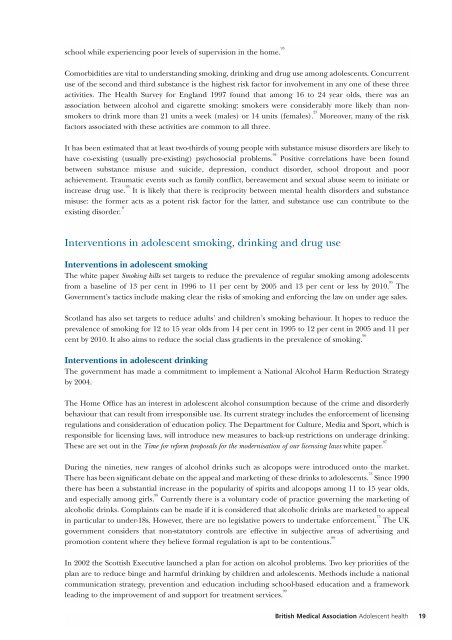Alcohol misuse: tackling the UK epidemic - London
Alcohol misuse: tackling the UK epidemic - London
Alcohol misuse: tackling the UK epidemic - London
Create successful ePaper yourself
Turn your PDF publications into a flip-book with our unique Google optimized e-Paper software.
school while experiencing poor levels of supervision in <strong>the</strong> home. 93<br />
Comorbidities are vital to understanding smoking, drinking and drug use among adolescents. Concurrent<br />
use of <strong>the</strong> second and third substance is <strong>the</strong> highest risk factor for involvement in any one of <strong>the</strong>se three<br />
activities. The Health Survey for England 1997 found that among 16 to 24 year olds, <strong>the</strong>re was an<br />
association between alcohol and cigarette smoking: smokers were considerably more likely than nonsmokers<br />
to drink more than 21 units a week (males) or 14 units (females). 23<br />
Moreover, many of <strong>the</strong> risk<br />
factors associated with <strong>the</strong>se activities are common to all three.<br />
It has been estimated that at least two-thirds of young people with substance <strong>misuse</strong> disorders are likely to<br />
have co-existing (usually pre-existing) psychosocial problems. 94<br />
Positive correlations have been found<br />
between substance <strong>misuse</strong> and suicide, depression, conduct disorder, school dropout and poor<br />
achievement. Traumatic events such as family conflict, bereavement and sexual abuse seem to initiate or<br />
increase drug use. 93<br />
It is likely that <strong>the</strong>re is reciprocity between mental health disorders and substance<br />
<strong>misuse</strong>: <strong>the</strong> former acts as a potent risk factor for <strong>the</strong> latter, and substance use can contribute to <strong>the</strong><br />
existing disorder. .9<br />
Interventions in adolescent smoking, drinking and drug use<br />
Interventions in adolescent smoking<br />
The white paper Smoking kills set targets to reduce <strong>the</strong> prevalence of regular smoking among adolescents<br />
from a baseline of 13 per cent in 1996 to 11 per cent by 2005 and 13 per cent or less by 2010. 95<br />
The<br />
Government’s tactics include making clear <strong>the</strong> risks of smoking and enforcing <strong>the</strong> law on under age sales.<br />
Scotland has also set targets to reduce adults’ and children’s smoking behaviour. It hopes to reduce <strong>the</strong><br />
prevalence of smoking for 12 to 15 year olds from 14 per cent in 1995 to 12 per cent in 2005 and 11 per<br />
cent by 2010. It also aims to reduce <strong>the</strong> social class gradients in <strong>the</strong> prevalence of smoking. 96<br />
Interventions in adolescent drinking<br />
The government has made a commitment to implement a National <strong>Alcohol</strong> Harm Reduction Strategy<br />
by 2004.<br />
The Home Office has an interest in adolescent alcohol consumption because of <strong>the</strong> crime and disorderly<br />
behaviour that can result from irresponsible use. Its current strategy includes <strong>the</strong> enforcement of licensing<br />
regulations and consideration of education policy. The Department for Culture, Media and Sport, which is<br />
responsible for licensing laws, will introduce new measures to back-up restrictions on underage drinking.<br />
These are set out in <strong>the</strong> Time for reform proposals for <strong>the</strong> modernisation of our licensing laws white paper. 97<br />
During <strong>the</strong> nineties, new ranges of alcohol drinks such as alcopops were introduced onto <strong>the</strong> market.<br />
There has been significant debate on <strong>the</strong> appeal and marketing of <strong>the</strong>se drinks to adolescents. 73<br />
Since 1990<br />
<strong>the</strong>re has been a substantial increase in <strong>the</strong> popularity of spirits and alcopops among 11 to 15 year olds,<br />
and especially among girls. 98<br />
Currently <strong>the</strong>re is a voluntary code of practice governing <strong>the</strong> marketing of<br />
alcoholic drinks. Complaints can be made if it is considered that alcoholic drinks are marketed to appeal<br />
in particular to under-18s. However, <strong>the</strong>re are no legislative powers to undertake enforcement. 73<br />
The <strong>UK</strong><br />
government considers that non-statutory controls are effective in subjective areas of advertising and<br />
promotion content where <strong>the</strong>y believe formal regulation is apt to be contentious. 99<br />
In 2002 <strong>the</strong> Scottish Executive launched a plan for action on alcohol problems. Two key priorities of <strong>the</strong><br />
plan are to reduce binge and harmful drinking by children and adolescents. Methods include a national<br />
communication strategy, prevention and education including school-based education and a framework<br />
leading to <strong>the</strong> improvement of and support for treatment services. 99<br />
British Medical Association Adolescent health 19
















